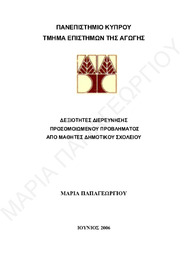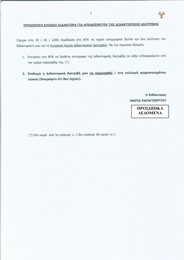| dc.contributor.advisor | Βαλανίδης, Νίκος | el |
| dc.contributor.author | Παπαγεωργίου, Μαρία Σωτήρη | el |
| dc.coverage.spatial | Κύπρος | el |
| dc.coverage.spatial | Cyprus | en |
| dc.creator | Παπαγεωργίου, Μαρία Σωτήρη | el |
| dc.date.accessioned | 2012-09-21T07:35:50Z | |
| dc.date.accessioned | 2017-08-03T09:39:33Z | |
| dc.date.available | 2012-09-21T07:35:50Z | |
| dc.date.available | 2017-08-03T09:39:33Z | |
| dc.date.issued | 2006-06 | |
| dc.date.submitted | 2006-06-28 | |
| dc.identifier.uri | https://gnosis.library.ucy.ac.cy/handle/7/39184 | en |
| dc.description | Περιέχει βιβλιογραφικές αναφορές (σ. 279-293). | el |
| dc.description | Αριθμός δεδηλωμένων πηγών στη βιβλιογραφία: 143 | el |
| dc.description | Διατριβή (διδακτορική) -- Πανεπιστήμιο Κύπρου, Σχολή Κοινωνικών Επιστημών και Επιστημών της Αγωγής, Τμήμα Επιστημών της Αγωγής, Ιούνιος 2006. | el |
| dc.description | Η βιβλιοθήκη διαθέτει αντίτυπο της διατριβής σε έντυπη μορφή. | el |
| dc.description | "Διδ. διατριβή στο γνωστικό αντικείμενο "Μάθηση στις Φυσικές Επιστήμες" – σ.τ. | el |
| dc.description.abstract | Η διατριβή αυτή αποσκοπούσε να μελετήσει τις δεξιότητες διερεύνησης παιδιών Δημοτικού σχολείου κατά τη λύση ενός προσομοιωμένου προβλήματος. Η έρευνα πραγματοποιήθηκε σε δύο φάσεις. Στην πρώτη φάση δόθηκαν ερωτηματολόγια σε 10 Δημοτικά σχολεία (498 παιδιά τετάρτης και έκτης τάξης) και εξέταζαν τις ικανότητες των παιδιών για έλεγχο μεταβλητών και τη συνδυαστική τους σκέψη. Στη δεύτερη φάση έγιναν συνεντεύξεις με 40 παιδιά τετάρτης και 40 παιδιά έκτης τάξης που επιλέγηκαν με βάση την επίδοση τους στο ερωτηματολόγιο. Για τις συνεντεύξεις, χρησιμοποιήθηκε μια πειραματική συσκευή με 8 λαμπτήρες και 5 διακόπτες που ήταν συνδεδεμένο» σε "κρυμμένο" κύκλωμα στο εσωτερικό της» Το παιδιά ανακοινώνοντας βήμα με βήμα τις σκέψεις τους και εκτελώντας πειράματα έπρεπε να ανακαλύψουν τη λειτουργία_και το διαφορετικό ρόλο των διακοπτών στη συσκευή και να πετύχουν τη φωτοβολία των λαμπτήρων. Κατά τη διερεύνηση, τα παιδιά έπρεπε, χρησιμοποιώντας τη συνδυαστική τους σκέψη, να πετύχουν όλους τους δυνατούς συνδυασμούς των διακοπτών μέχρι τη λύση του προβλήματος. Επιπλέον ο αριθμός διακοπτών που μετακινούσαν από μια πειραματική προσπάθεια σε άλλη φανέρωνε την ικανότητα τους για έλεγχο μεταβλητών. Από τα αποτελέσματα της πρώτης φάσης της έρευνας φάνηκε ότι τα παιδιά είχαν αναπτύξει σε μεγαλύτερο βαθμό τη συνδυαστική τους σκέψη παρά τη δεξιότητα ελέγχου μεταβλητών. Επιπλέον τα κορίτσια σημείωσαν στατιστικά υψηλότερη επίδοση από ότι τα αγόρια και τα παιδιά της έκτης τάξης σημείωσαν στατιστικά υψηλότερη επίδοση από τα παιδιά της τετάρτης τάξης. Όσον αφορά τα αποτελέσματα της δεύτερης φάσης τα παιδιά συνάντησαν δυσκολίες στην προσπάθεια τους να λύσουν το προσομοιωμένο πρόβλημα. Αρκετά παιδιά κατάφεραν να εντοπίσουν τους διαφορετικούς διακόπτες, τα περισσότερα όμως με μη αποτελεσματικό τρόπο. Ο μη αποτελεσματικός τρόπος αφορούσε την εκτέλεση πειραμάτων σε επανάληψη, το μη συστηματικό έλεγχο των μεταβλητών, τη μη συστηματική οργάνωση και αξιοποίηση όλων των δεδομένων, με αποτέλεσμα να οδηγούνται στη λύση μετά από τυχαίες, περιπλανήσεις στο χώρο των πειραμάτων και όχι μετά από συντονισμό των υποθέσεων και των δεδομένων τους. Η ηλικία και οι ικανότητες των παιδιών όπως φάνηκαν μέσα από το ερωτηματολόγιο, επηρέασαν τη διερευνητική ικανότητα των παιδιών. Οι διαπιστώσεις αυτές μπορούν να αξιοποιηθούν για το σχεδιασμό διδακτικών σεναρίων με στόχο την ανάπτυξη των γνωστικών ικανοτήτων των παιδιών και την καθοδήγηση μελλοντικών ερευνών προς αυτή την κατεύθυνση. | el |
| dc.description.abstract | The study investigated forth and sixth grade students' cognitive abilities and problem-solving strategies and took place in two distinct phases. The sample of the first phase was 498 forth and sixth grade students from 10 primary schools in Cyprus. The data were collected with a questionnaire concerning control of variable ability and combinatorial reasoning. At the second phase eighty students were chosen from the broader sample of the first phase and were individually interviewed as they were investigating a simulated scientific problem. Each interviewee was asked to "think aloud," prior and after any experiment with a simple device. The device consisted of a wooden box with 8 small electric lambs in a line and 5 switches, in another line below the bulbs, which could move up and down. The bulbs and the switches were connected in a "hidden" circuit inside the box, in a way that only one or none of the lamps could light on, while a "tester," or a general switch, located below the 5 switches, was used to test whether one or more lamps were lit on. The interviewees were also instructed to proceed in a step-by-step fashion and keep a record of their observations. The transcribed interviews were analysed. The results of the first phase showed that the pupils had developed their combinatorial reasoning than their ability to control variables. Moreover girls had higher performance than boys and six graders had higher performance than forth graders. The results of the second phase showed some pupils were able to solve the problem, but with an ineffective way. The ineffective way refers to their inability to employ the control-of-variables strategy, to perform identical experiments and to their difficulties to effectively organise their results and, thus, did not take full advantage of their "system of external memory." They did not, furthermore, exhibit ability to co-ordinate their hypotheses with the collected evidence. Age and performance on the questionnaire had a main effect on pupils' investigation ability. The results of the study can guide further research for identifying patterns of children's cognitive development and design of teaching scenarios conducive to accelerating their cognitive growth. | en |
| dc.format.extent | iii, 326 σ. : εικ. ; 31 εκ. | el |
| dc.language.iso | gre | en |
| dc.publisher | Πανεπιστήμιο Κύπρου, Σχολή Κοινωνικών Επιστημών και Επιστημών Αγωγής / University of Cyprus, Faculty of Social Sciences and Education | |
| dc.rights | info:eu-repo/semantics/openAccess | en |
| dc.rights | Open Access | en |
| dc.subject.lcsh | Physics, Experiments | en |
| dc.subject.lcsh | Physics projects | en |
| dc.subject.lcsh | Physics, Study and teaching (Elementary) | en |
| dc.subject.lcsh | Problem solving | en |
| dc.title | Δεξιότητες διερεύνησης προσομοιωμένου προβλήματος από μαθητές δημοτικού σχολείου | el |
| dc.title.alternative | Primary pupils’ investigation abilities and problem solving strategies | en |
| dc.type | info:eu-repo/semantics/doctoralThesis | en |
| dc.contributor.committeemember | Βαλανίδης, Νίκος | el |
| dc.contributor.committeemember | Φιλίππου, Γιώργος | el |
| dc.contributor.committeemember | Παπαναστασίου, Κωνσταντίνος | el |
| dc.contributor.committeemember | Κόκκοτας, Παναγιώτης | el |
| dc.contributor.committeemember | Μαρκουλής, Διομήδης | el |
| dc.contributor.committeemember | Valanides, Nicos | en |
| dc.contributor.committeemember | Filippou, Giorgos | en |
| dc.contributor.committeemember | Papanastasiou, Constantinos | en |
| dc.contributor.committeemember | Kokkotas, Panagiotis | en |
| dc.contributor.committeemember | Markoulis, Diomidis | en |
| dc.contributor.department | Πανεπιστήμιο Κύπρου, Σχολή Κοινωνικών Επιστημών και Επιστημών της Αγωγής, Τμήμα Επιστημών της Αγωγής | el |
| dc.contributor.department | University of Cyprus, Faculty of Social Sciences and Education, Department of Education | en |
| dc.subject.uncontrolledterm | ΛΥΣΗ ΠΡΟΒΛΗΜΑΤΟΣ | el |
| dc.subject.uncontrolledterm | ΕΠΙΣΤΗΜΟΝΙΚΟΣ ΤΡΟΠΟΣ ΣΚΕΨΗΣ | el |
| dc.subject.uncontrolledterm | ΕΠΙΣΤΗΜΟΝΙΚΕΣ ΔΙΑΔΙΚΑΣΙΕΣ | el |
| dc.subject.uncontrolledterm | ΧΩΡΟΣ ΥΠΟΘΕΣΕΩΝ | el |
| dc.subject.uncontrolledterm | ΧΩΡΟΣ ΠΕΙΡΑΜΑΤΩΝ | el |
| dc.subject.uncontrolledterm | ΕΛΕΓΧΟΣ ΜΕΤΑΒΛΗΤΩΝ | el |
| dc.subject.uncontrolledterm | ΣΥΝΔΥΑΣΤΙΚΗ ΣΚΕΨΗ | el |
| dc.subject.uncontrolledterm | ΣΥΝΤΟΝΙΣΜΟΣ ΥΠΟΘΕΣΕΩΝ ΚΑΙ ΔΕΔΟΜΕΝΩΝ | el |
| dc.subject.uncontrolledterm | SCIENTIFIC REASONING | en |
| dc.subject.uncontrolledterm | SCIENTIFIC PROCESSES | en |
| dc.subject.uncontrolledterm | HYPOTHESIS SPACE | en |
| dc.subject.uncontrolledterm | EXPERIMENTAL SPACE | en |
| dc.subject.uncontrolledterm | CONTROL OF VARIABLES | en |
| dc.subject.uncontrolledterm | COMBINATORIAL REASONING | en |
| dc.subject.uncontrolledterm | COORDINATION OF THEORY AND EVIDENCE | en |
| dc.identifier.lc | QC33.P37 2006 | en |
| dc.author.faculty | Σχολή Κοινωνικών Επιστημών και Επιστημών Αγωγής / Faculty of Social Sciences and Education | |
| dc.author.department | Τμήμα Επιστημών της Αγωγής / Department of Education | |
| dc.type.uhtype | Doctoral Thesis | en |
| dc.rights.embargodate | 2006-06-28 | |


